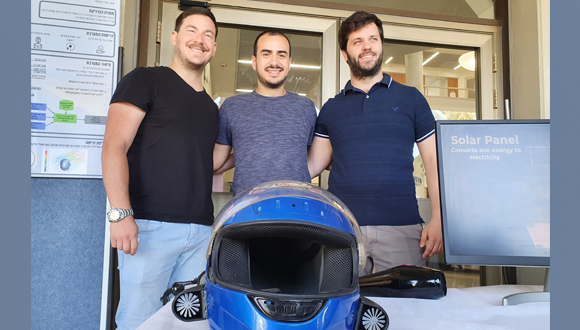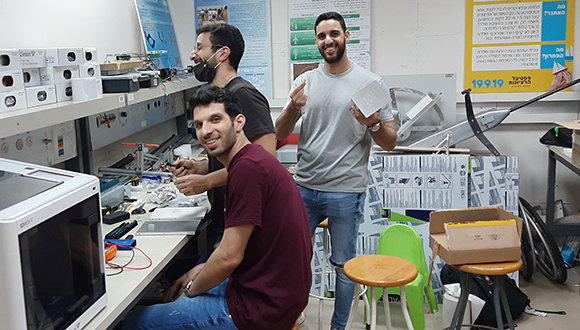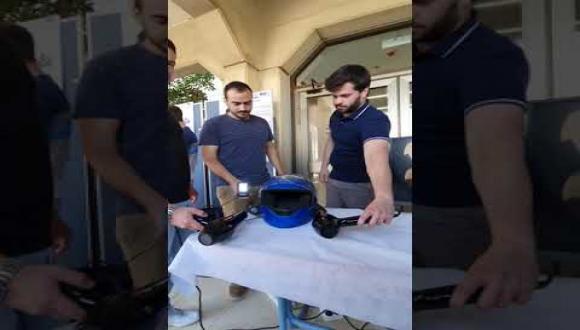The Faculty of Engineering Predicts: A Greener and Safer Future
Graduates of TAU’s School of Mechanical Engineering present innovative projects
Just like every year, graduates of the School of Mechanical Engineering of The Iby and Aladar Fleischman Faculty of Engineering recently presented the projects they have been working on throughout their final year of studying towards their degree. A lot of ground was covered, with one project promising those suffering from nightmares after trauma to sleep peacefully, another offering a robot capable of disinfecting aircrafts from viruses, and other teams have developed drones designed and developed to transport defibrillators and first aid kits through areas that are either difficult or downright impossible to access from the ground. Seeing these original ideas makes it clear how the faculty’s motto is befitting for those who enter (and perhaps even more so for those who exit) its gates: “Those who fall in love with a problem are the ones who will find a solution to it.”
Thinking Within the Box
We use them every day, usually multiple times a day, but how much thought do we dedicate to the garbage bins in our homes? And, while we’re on the subject, have you ever thought to calculate how many garbage bags you dispose of every year? As environmentally-conscious people, Tal Kelmachter and Nimrod Ben-Yehuda have given this more than a little thought, and got inspired to design their very own garbage can.
The exterior part of the bin does not distinguish itself much from your standard garbage bin. The secret is hidden within the box: the uniqueness of this product is that it does not require a plastic bag, which is an environmental hazard. Nimrod explains, “We designed it as a stand-alone solution which does not require any special infrastructure, like drainage, water supply and electricity. Once you have emptied the contents of the garbage bin, an integral rinsing mechanism cleanses it on the inside, easily and quickly. The water is contained in a clean water container, and a mechanical pump forces the water through a system of pipes with a no-return valve to a system of sprinklers that showers the sides of the tin from the inside. The dirty water then flows into a dedicated water drawer which is easy to empty. The result is a garbage bin that remains clean and free of bad odors and contaminants.”
Tal adds, “During the past few years there has been increased awareness which has led to a growing trend of reducing plastic use and recycling. And yet, there is currently no product on the market that completely prevents the use of garbage bags. Nimrod and I managed to find a solution to this problem.”

Tal Kelmachter and Nimrod Ben-Yehuda with their green garbage bin, ECOCAN
Enjoy the Ride
A few minutes into Aviv Halachmi’s motorcycle drive to his girlfriend in Beer Sheva, his headset ran out of battery. The annoying experience motivated Aviv to form the ChargElmet team together with fellow students Tal Belilty and Itay Shulman.
“Motorcyclists attach a variety of electronic components to their helmets, such as hands free and camera, in order to enhance their riding experience. These utilities have batteries that require charging. We designed and built a system which uses the wind and the sun to produce green energy to charge gadgets from motorcycle helmets while you travel”, says Aviv.
Did the project become a smoother ride than Aviv’s trip to his girlfriend? Not at all. The team ran into plenty of difficulties along the way: “The system we created is multidisciplinary and contains a lot of engineering elements from various fields, not all related to mechanical engineering, such as electrical diagrams, electrical design including the investigation and selection of the appropriate cards and components and much more. So, we were forced to learn a lot while on the job. That being said, solving issues that arose throughout the process and accomplishing the end product brought us tremendous satisfaction,” he shares.
Aviv concludes, “For now, our invention is geared towards motorcyclists and improving their lives. In the future, we plan to expand the project to address all two-wheelers (bicycles, scooters...). On a macro level, our vision is to improve public awareness of green energy and to take part in the global trend of promoting and transitioning to renewable energy.”

Itay Shulman, Tal Belilty and Aviv Halachmi found a way to improve other motorcyclists' lives
Hover and Save
This year, the presence of the drone stood out in the Innovate project (a cooperation between TAU and Elbit Systems Ltd), which encompasses several complementary projects on the subject of detecting, rescuing and making life-saving first aid accessible to those trapped under earthquake ruins.
May Davidovich and Ariel Drizin tell us about their part in the project:” We presented a design and a preliminary prototype for a robotic first aid release arm system, installed on a drone and controlled by a dedicated control system, making it easier for the rescue forces to maneuver among the trapped and offer them first aid. In the future, the project can be advanced by allowing for larger systems capable of carrying heavier kits.”
“Our premise was that the system we were planning would be part of a swarm of drones, including one that would scan and photograph the area, a parent drone that would carry a large number of kits, and drones that would know how to receive kits from the parent glider, bring these to the person(s) trapped and then to release the kit. The system will be controlled by an operator from his control room, who will receive information about the trapped, put together a suitable kit, bring it to the disaster stricken area, and release it as close as possible to the trapped.”
May recounts sleepless nights: “The system worked fine up until a few days before the project was to be presented. As we were putting the parts together, we discovered that we had made some measurement errors prior to the printing of the parts, which meant the components didn’t work properly together.”
“We also had to make several design changes and print the model three times before we achieved the desired result. We learnt that when you print the prototype, you need to consider the system in its entirety, which is hard to do before all the components arrive. It is a time-consuming process which requires a lot of planning in advance.”
“We hope that our invention will help streamline the process of rescuing people who are trapped. For instance, by taking measures and signaling back to the control room the severity of the physical condition of victims, so the rescue can be prioritized accordingly. There are many more potential usages, not necessarily related to rescue, such as grocery delivery from the supermarket.”

Extending their robotic arm. Ariel Drizin and May Davidovich.
Saving the Black Box
Did you know that every plane crash is investigated in depth to determine the cause of the crash? Yaniv Alon, Dor Cohen and Ido Rosenzweig designed a system to be ejected from a plane in the event of a crash, and which transmits location details and additional data, significantly reducing the radius of the search for a plane when contact has been lost.
“The system includes a smart box with electronics and internal controllers. When it recognizes that the plane is about to crash, it is ejected from the plane at high speed with the help of mechanisms that we developed. It then falls to the ground with a parachute and can weather any condition, on land or sea.”, explains Yaniv. He clarifies that the system is not meant to replace the black box, but rather it is meant to offer a better alternative to the aircraft transmission systems that exist today, which tend not to be resilient or ejected, and usually vary according to the aircraft systems.
They started working on the project already last year. After a thorough examination of the system’s weaknesses and failures they undertook significant adjustments and enhancements before presenting the product this year. “We encountered quite a few complications along the way, when deciding how to operate the mechanism, examining various alternatives, finding suitable components, communication with suppliers, delivery delays and manufacturing glitches, requiring us to do ping-pong between the workshop and the production. However, thanks to our combined creativity, determination, efforts and our dedicated project manager Danny Barko, we were able to create a functioning product.”, he says.
When asked how they think their invention will contribute to change our lives, Yaniv replies, “The two main problems those who investigate plane crashes are faced with today, are that the black boxes are not ejected and that they are not resilient, which means that they mostly disappear along with the the aircraft. Unproductive field searches can reach sums of around $155 million. A system is required that will allow for swift and effective investigations and save us a lot of resources and money. Our solution meets these requirements and might even end up saving lives by helping locating crashed planes and their black boxes, advancing the investigation of the failures that led to the planes’ crash and preventing similar future cases.”

Will they help find the black box? Ido Rosenzweig, Dor Cohen and Yaniv Alon



